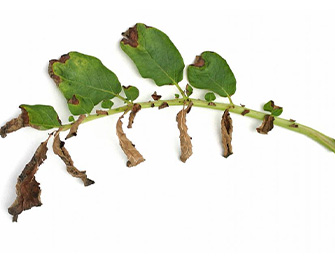Please click here to access the main AHDB website and other sectors.
- Home
- Knowledge library
- Verticillium Wilt
Verticillium Wilt
Symptoms
The disease is often seen as scattered patches in a field and can result in stunting, premature plant senescence and ultimately a reduced yield. Plants may lose turgor and wilt especially on hot sunny days. Leaflets can curl, turn pale green or yellow and become desiccated, sometimes starting at the tips. The stem vascular ring often discolours brown which is most easily seen by cutting a long slanting cross-section at ground level. Symptoms which appear restricted to one side of a compound leaf (see image) or even leaflet are diagnostic of this disease. Tuber symptoms are rare in the UK but may appear as vascular discolouration from the stolon end.Conditions
The pathogens have wide host ranges. Verticillium is mainly soil-borne but can be spread on soil attached to seed. Both species are able to survive within plant debris or in the soil for years. High soil water levels favour infection.Control
Control is most effective with an integrated approach. Use clean, disease free seed, long rotations (preferably over four years) and alternate with non-susceptible crops. Be careful when irrigating as high soil water levels favour infection. Avoid sites with high levels of root damaging nematodes as they are thought to increase infection by providing an entry site for the pathogen.


